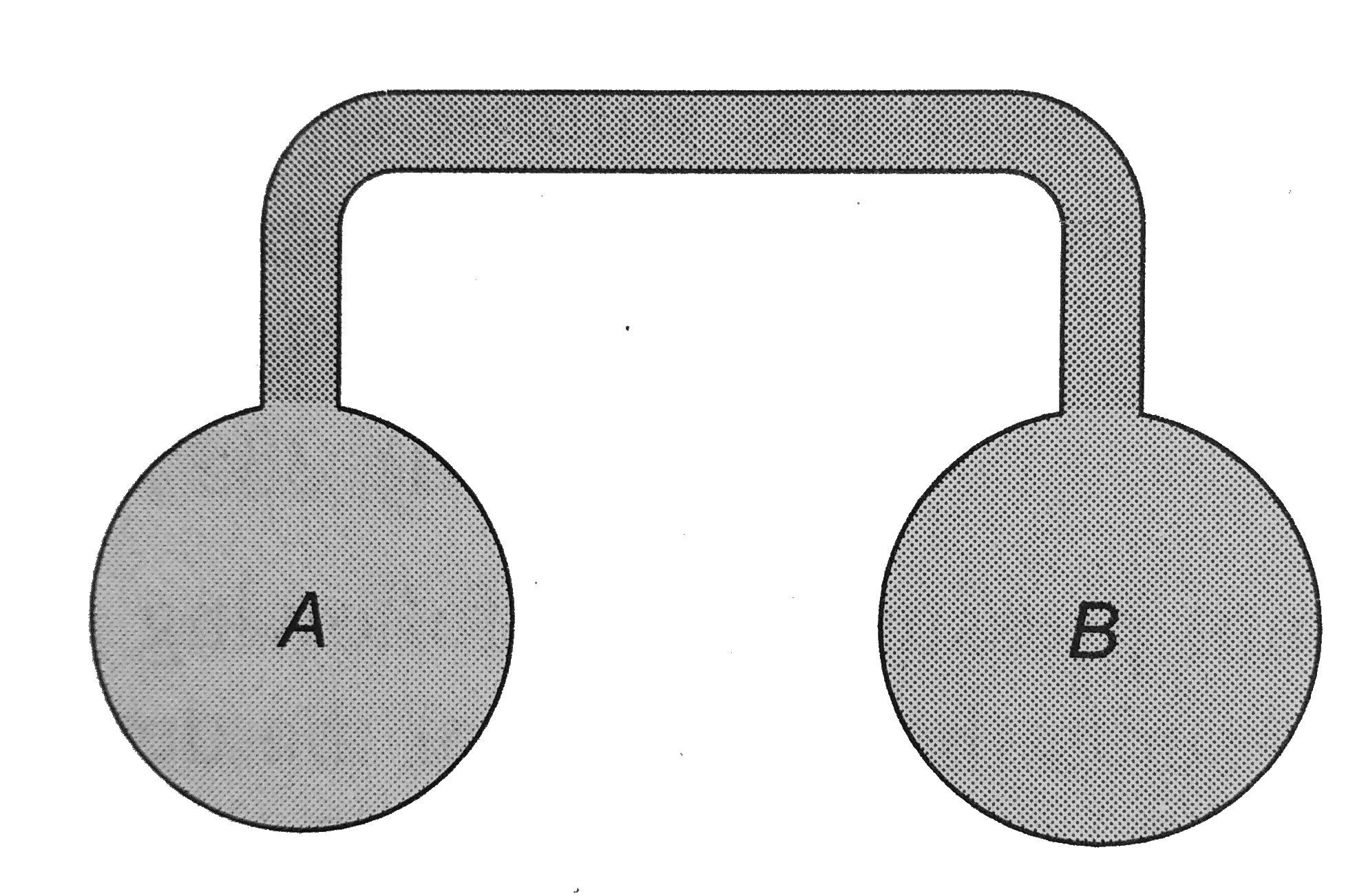Two cylinders A and B of equal capacity are connected to each other vis a stop cock. A contains an ideal gas at standard temperature and pressure. B is completely evacuated. The sto cock is suddenly opened. The process is:
isothermal
adiabatic
isochoric
isobaric
To solve the problem, we need to analyze the situation when the stopcock between the two cylinders A and B is suddenly opened. Here's a step-by-step breakdown of the process:
Step 1: Understanding the Initial Conditions
- Cylinder A contains an ideal gas at standard temperature and pressure (STP).
- Cylinder B is completely evacuated (a vacuum).
- The system is thermally insulated, meaning no heat can enter or leave the system.
Hint: Recognize the initial state of both cylinders and the properties of the gas in cylinder A.
Step 2: Opening the Stopcock
- When the stopcock is opened, the gas from cylinder A will expand into cylinder B.
- Since cylinder B is a vacuum, the gas will have no opposing pressure to push against.
Hint: Consider what happens to the gas molecules when they are allowed to expand into a vacuum.
Step 3: Identifying the Type of Expansion
- The expansion of gas into a vacuum is known as free expansion.
- In free expansion, the gas expands without doing any work on the surroundings because there is no external pressure.
Hint: Recall the definition of free expansion and how it differs from other types of expansions.
Step 4: Analyzing Work Done
- The work done (W) during an expansion is given by the formula W=PΔV.
- Since cylinder B is a vacuum, the pressure (P) is zero, leading to W=0.
Hint: Remember that work done is related to pressure and volume change.
Step 5: Considering Internal Energy and Temperature
- In an adiabatic process, if no heat is exchanged and no work is done, the internal energy of the gas remains constant.
- For an ideal gas, if the internal energy is constant, the temperature also remains constant.
Hint: Think about the relationship between internal energy, temperature, and the nature of the gas.
Step 6: Conclusion
- Although the temperature remains constant during the free expansion, the process is not isothermal because the gas does not exchange heat with the environment.
- The correct classification of the process when the stopcock is opened is adiabatic because it occurs suddenly and without heat exchange.
Final Answer: The process is adiabatic.
- Cylinder A contains an ideal gas at standard temperature and pressure (STP).
- Cylinder B is completely evacuated (a vacuum).
- The system is thermally insulated, meaning no heat can enter or leave the system.
- When the stopcock is opened, the gas from cylinder A will expand into cylinder B.
- Since cylinder B is a vacuum, the gas will have no opposing pressure to push against.
- The expansion of gas into a vacuum is known as free expansion.
- In free expansion, the gas expands without doing any work on the surroundings because there is no external pressure.
- The work done (W) during an expansion is given by the formula W=PΔV.
- Since cylinder B is a vacuum, the pressure (P) is zero, leading to W=0.
- In an adiabatic process, if no heat is exchanged and no work is done, the internal energy of the gas remains constant.
- For an ideal gas, if the internal energy is constant, the temperature also remains constant.
- Although the temperature remains constant during the free expansion, the process is not isothermal because the gas does not exchange heat with the environment.
- The correct classification of the process when the stopcock is opened is adiabatic because it occurs suddenly and without heat exchange.
Topper's Solved these Questions
Similar Questions
Two cyclinder A and B of equal capacity are connected to eachother via a stopcock. The cyclinder A contains an ideal gas at standard temperature and pressure, while the cyclindr B is completely evacuated. The entire system is thermally insulated. The stopcock is suddenly opened. Answer the following:
(a) What is the final pressure of the gas in A and B?
(b) What is the change in internal energy of the gas?
(c ) What is the change in temperature of a gas?
(d) Do the intermidiate states of the system (before settling to the final equilibrium state)lie on its P−V−T surface?
View SolutionA mixture containing 1.12 litre D2 and 2.24 liter of H2 at NTP is taken inside a bulb connected to another bulb through a stop cock with a small opening The second bulb is fully evacuated The stop cock is opened for a crtian time and then closed The first bulb is now found to contain 0.10g of D2 Determine the % by weight of the gases in second bulb
 .
.
View Solution
Knowledge Check
Two cylinders A and B of equal capacity are connected to each other vis a stop cock. A contains an ideal gas at standard temperature and pressure. B is completely evacuated. The sto cock is suddenly opened. The process is:
AAdiabaticBIsochoricCIsobaricDIsothermalA container with insulating walls is divided into two equal parts by a partition fitted with a valve. One part is filled with an ideal gas at a pressure P and temperature T, whereas the other part is completely evacuated . If the valve is suddenly opened, the pressure and temperature of the gas will be
AP2,TBP2,T2CP, TDP,T2Two flasks A and B of equal capacity of volume contain SO3 and CO gas respectively under similar conditions of temperature and pressure. Then, which of the following statement is true?
AA has twice the number of moles as that of BBB has twice the number of moles as that of ACA and B have equal number of molesDB has twice the number of atoms as that of A
Two flask A and B of equal capacity contains CO2 and O2 gas under similar conditions their ratio of atoms is :-
View SolutionA cylinder of fixed capacity 44.8 litre. contains a monatomic gas at standard temperature and pressure. The amount of heat required to cylinder by 10∘C will be.
( R= univerasl gas constant )
View SolutionTwo bulbs 'X' and 'Y' of equal volumes are connected through a stop cock. Each bulb contained 9.6 g of dioxygen gas at 0.4 atm pressure and 300 K The first bulb 'X' is then heated to 500K keeping bulb 'Y' at 300 K.
Final pressure in bulb 'X' is:
View SolutionTwo bulbs 'X' and 'Y' of equal volumes are connected through a stop cock. Each bulb contained 9.6 g of dioxygen gas at 0.4 atm pressure and 300 K The first bulb 'X' is then heated to 500K keeping bulb 'Y' at 300 K.
Final number of moles of dioxygen in vessel 'Y' would be:
View SolutionTwo spherical vessel of equal volume are connected by a n arrow tube. The apparatus contains an ideal gas at one atmosphere and 300K. Now if one vessel is immersed in a bath of constant temperature 600K and the other in a bath of constant temperature 300K. then the common pressure will be

View Solution
